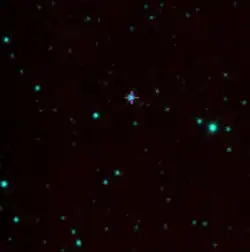| Observation data Epoch J2000 Equinox J2000 | |
|---|---|
| Constellation | Libra[1] |
| Right ascension | 15h 37m 06.215s[2][3] |
| Declination | −19° 08′ 33.09″[2][3] |
| Apparent magnitude (V) | 9.84[4] |
| Characteristics | |
| Spectral type | G3/G5V[5] |
| Astrometry | |
| Radial velocity (Rv) | 16.36[6] km/s |
| Proper motion (μ) | RA: −67.594[6] mas/yr Dec.: −92.516[6] mas/yr |
| Parallax (π) | 9.2966 ± 0.0472 mas[6] |
| Distance | 351 ± 2 ly (107.6 ± 0.5 pc) |
| Details | |
| Radius | 1.14[6] R☉ |
| Luminosity (bolometric) | 1.29[6] L☉ |
| Temperature | 5,766[6] K |
| Rotation | 14.5 d[7] |
| Age | 1.5±0.4[7] Gyr |
| Other designations | |
| Database references | |
| SIMBAD | data |
HD 139139 (also known as EPIC 249706694) is likely part of a bound pair system of main sequence stars about 350 light-years (110 parsecs) away from Earth in the constellation Libra. HD 139139 is a G-type main-sequence star, a little larger and more luminous than the Sun, and at an almost identical temperature. It has an apparent magnitude of 9.8. The companion star is thought to be a K5-K7 red dwarf 3.3″ away from HD 139139. It is about three magnitudes fainter and has a temperature of between 4,100 and 4,300 K.[7] Both stars have a similar proper motion, meaning they may form a gravitationally-bound binary pair.
HD 139139 exhibits dips in brightness similar to those caused by transiting Earth-like planets.[7] The Kepler space telescope observed 28 dips in their brightness over an 87-day period (23 August – 20 November 2017).[8][9] The dips do not appear to be periodic as would be expected if they were due to transiting planets.[10][11][12]
It is unknown which of the two stars produces the dimming events.[7] Potential explanations that have been investigated include planets transiting a binary star, planets that are perturbing the orbits of each other producing large transit timing variations, a disintegrating planet, large dust producing asteroids, and short lived sunspots.[7][13][14] According to Andrew Vanderburg, one of the researchers of the original studies,
Background
HD 139139 was identified as unusual by two independent groups of visual surveyors (citizen scientists) working in collaboration with professional astronomers.
- "But some of these patterns are too complex for computers to tease out; volunteer citizen scientists also comb through the Kepler catalogue, using the human brain's power to uncover surprising signals. In spring 2018 some of these citizen astronomers contacted Vanderburg and told him to check out HD 139139, a sunlike star roughly 350 light-years away."[7][10]
HD 139139 is one of the 0.5% of stars in the sky that can see Earth transit, according to Andrew Vanderburg. "The transit impact parameter would be close to 0.9, so they can just barely see us – the transit duration would be only about 40% the duration we'd expect for a perfectly edge-on transit."[16]
See also
References
- ↑ "Finding the constellation which contains given sky coordinates". DJM.cc. 2 August 2008. Retrieved 8 June 2019.
- 1 2 "Basic data: HD 139139 – high proper-motion star". SIMBAD. 2019. Retrieved 7 July 2019.
- 1 2 "K2 search results – EPIC 249706694". Space Telescope Science Institute (STScI.edu). 2019. Retrieved 5 July 2019.
- ↑ Høg, E.; Fabricius, C.; Makarov, V.V.; Urban, S.; Corbin, T.; Wycoff, G.; et al. (2000). "The Tycho 2 catalogue of the 2.5 million brightest stars". Astronomy and Astrophysics. 355: L27. Bibcode:2000A&A...355L..27H.
- ↑ Houk, N.; Smith-Moore, M. (1988). Michigan Catalogue of Two-dimensional Spectral Types for the HD Stars. Vol. 4: Declinations −26°.0 to −12°.0. Bibcode:1988mcts.book.....H.
- 1 2 3 4 5 6 7 Brown, A. G. A.; et al. (Gaia collaboration) (August 2018). "Gaia Data Release 2: Summary of the contents and survey properties". Astronomy & Astrophysics. 616. A1. arXiv:1804.09365. Bibcode:2018A&A...616A...1G. doi:10.1051/0004-6361/201833051. Gaia DR2 record for this source at VizieR.
- 1 2 3 4 5 6 7 Rappaport, S.; Vanderburg, A.; Kristiansen, M.H.; Omohundro, M. R.; Schwengeler, H.M.; Terentev, I.A.; et al. (2019). "The Random Transiter – EPIC 249706694/HD 139139". Monthly Notices of the Royal Astronomical Society. 488 (2): 2455–2465. arXiv:1906.11268. Bibcode:2019MNRAS.488.2455R. doi:10.1093/mnras/stz1772. S2CID 195699431.
- ↑ Starr, Michelle (2 July 2019). "Astronomers found a star that dims so erratically, they have no explanation for it". ScienceAlert.com. Retrieved 4 July 2019.
- ↑ Yirka, Bob (3 July 2019). "Binary stars with unexplainable dimming pattern". Phys.org. Retrieved 4 July 2019.
- 1 2 Mann, Adam. "Astronomers don't know what to make of this incredibly bizarre star". Scientific American. Retrieved 3 July 2019.
- ↑ Mandelbaum, Ryan F. (2 July 2019). "Freaky star seems to dim randomly, and astronomers don't know why". Gizmodo. Retrieved 3 July 2019.
- 1 2 Crane, Leah (2 July 2019). "The weirdest stars we've ever seen have astronomers utterly baffled". New Scientist. Retrieved 4 July 2019.
- ↑ Osborn, Hugh (29 June 2019). "Why the 'Random Transiter' is now the most mysterious star in the Galaxy". HughOsborn.co.uk. Retrieved 19 July 2019.
- ↑ Schirmer, H. (30 June 2019). "Why the 'Random Transiter' (HD139139) is now the most mysterious star in the Galaxy". Reddit. Retrieved 19 July 2019.
- ↑ "'Something Weird Going On' –'Random-Transiter' Star System Stumps Scientists". The Daily Galaxy. 3 July 2019. Archived from the original on 20 July 2019. Retrieved 19 July 2019.
- ↑ Godier, John Michael; Andrew, Vanderburg. The mysterious star HD 139139 with Dr. Andrew Vanderburg. YouTube (video 30m36s ). Retrieved 13 July 2019.
External links
- "EPIC Catalog at MAST". Space Telescope Science Institute (stsci.edu).
- HD 139139 summary & related (video 8m57s ) on YouTube
- The mysterious star HD 139139 with Dr. Andrew Vanderburg (video 30m36s ) on YouTube
- HD 139139 summary. kgw.com (video 1m00s ). Archived from the original on 4 July 2019. Retrieved 4 July 2019.
